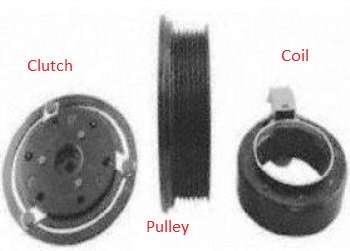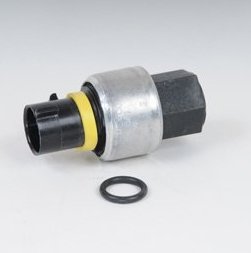
Automobile air conditioning electrical problems aren’t as common as AC Freon slow leak issues, but I have seen them enough to warrant a page about it.
Pictured to the right are the three main components of a serpentine belt driven electronic compressor clutch assembly. The belt driven pulley (middle) is the muscle that turns the compressor.
the electromagnetic clutch coil (right) uses a powerful magnet to engage it on command. The compressor clutch itself (left) contains friction material and locks the unit together as one piece. When the clutch is applied it turns a drive-shaft that runs the internal components.
The complete operation is described in more detail below. More than once I have approached a vehicle with an air conditioning system not working and wiggled a connector then heard the AC clutch engage.
Automotive electrical systems on any part of the vehicle are susceptible to poor connections and corrosion despite the modern weather resistant connectors deployed throughout the vehicle.
As I spoke about before on several pages throughout the you fix cars site, a good visual inspection is a good place to start with many car problems.
Below I will give you some specific examples of things you can visually inspect plus a few helpful tips for electrical diagnosis on automotive air-conditioning systems.
Car Air Conditioning Electronics

Auto air conditioning systems contain various switches and relays. There will be times when one of them won’t function as per design intent. Here is a quick article about how to test relays and switches.
But sometimes the malfunction isn’t due to the component itself. Instead it’s caused by a bad connection or corrosion that has built up on the leads. The air conditioning systems on today’s automobiles are loaded with switches.
A few examples would be a low-pressure cut off switch, high pressure cutoff switch, power steering switch, wide open throttle switch. These are designed to disengage the compressor temporarily while loads are increased in various other systems.
What if it fails? The compressor will not turn on and the air blows warm is the answer to this common question. You also have the interior switches such as the AC on/off switch and the blower control that’s a multiple position switch.
If any of these switches malfunction or have poor contact at the connectors the driver complains that the air conditioning doesn’t work.
I built a complete diagnostic page for blower motor problems that’s become popular. When an electrical switch malfunctions it can be tested with a $9 dollar meter.
Most automotive meters have a continuity test function to see if the switch allows current to pass through. There’s no need for guessing, but there is a need for logical testing. Don’t waste your money on parts that aren’t broken.
I have said it before, but please remember you should always consult your car service manuals for the specifics of testing the system on your particular vehicle. The factory manual is better then any forum or static web page that you will run into, including this one.
Electrically Operated AC Components
I have seen my share of compressor clutch failures. This part can be serviced and replaced separately from the compressor. So I just wanted to explain a little more about this very important part of the auto air-conditioning system.
The compressor clutch is an electromagnetic unit that is energized by a coil that physically pulls the clutch in to grip against the belt driven air-conditioning pulley.
It provides the mechanical connection that turns engine revolutions into a Freon pump. You can test the electrical portion of the compressor clutch with an ohmmeter. There will be a specific resistance value for your vehicle.
But often I will find the compressor clutch coil will have an open in it and that is easily tested with a automotive style multimeter. If there is no resistance value registered on the meter (or OL) then this is most likely your problem. Replacing the compressor clutch can be a touchy operation.
The gap between the clutch material and the air-conditioning pulley is very critical. In most cases this air gap should be between .35 mm and .85 mm.
Again, this will vary with your model automobile. But my point of this discussion is if the air gap is too large, the clutch will slip when it is engaged.
If the air gap is too small the clutch material will start to wear quickly as it will not fully release from the compressor pulley as it spins. This can also cause strange air conditioner noises with the panel switch in the off position.
I have a page that describes not only how your car removes the heat from the passenger compartment but also shows a good diagram of how air conditioning works.
The preceding electrical problems are just a few of the common ones I have seen recently. There is a lot of other stuff that can go wrong with automotive air-conditioning.
The best way to diagnose problems is to understand how it works. This next link will take you from this page about electrical problems to the main car AC page.
The YouFixCars.com homepage is a great place to go to find out what else is covered on this DIY automobile website.

